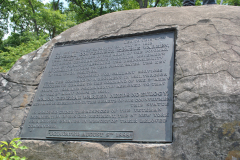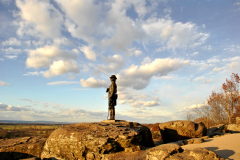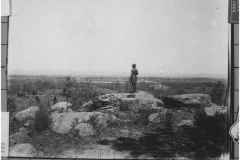Dedicated: Aug. 8, 1888.
Location: Located on summit of Little Round Top.
Description: A standing portrait of General Warren holding binoculars in his raised proper right hand. The sculpture rests on a boulder atop Little Round Top near the Union line later occupied by the 155th Pennsylvania Infantry. Members of Warren’s former command, the 5th New York Infantry, spearheaded the monument project. All of the money was privately raised. The boulder upon which the monument sits is all considered part of the memorial and visitors to the Park are forbidden to climb upon it (though many still do anyway). A bronze tablet was added by the War Department to prohibit visitors from climbing on the boulder in 1890. A bronze inscription tablet is located on the northwest face of the boulder and the word “Warren” is cut into the top of the boulder. Overall height is 8.4 feet. It was erected at the cost of $5,000.00. General Warren is portrayed looking over the battlefield as he did on July 2, 1863 when he ordered the Union troops to defend Little Round Top from advancing Confederate troops.
National Park Service List of Classified Monuments Number: MN99.
Sculptor: Karl Gerhardt
About Major General Gouverneur Kemble Warren
General Warren was born on January 8, 1830 in Cold Springs, New York; he was named for Gouverneur Kemble, a prominent local Congressman and owner of the West Point Foundry. Warren graduated from West Point in 1850 and took a commission in the corps of topographical engineers. In this role, he mapped much of the west.
He was an instructor at West Point when the War broke out and joined the 5th New York Infantry. He commanded a brigade for a time and was selected as Army of the Potomac chief engineer by Joe Hooker. Warren was integral in saving Little Round Top on July 2, where he was slightly wounded in the neck.
Warren later commanded the Fifth Corps, earning the displeasure of Grant and Sheridan who thought him too slow. He was relieved from command at Five Forks and spent much of the rest of his life as a major of engineers and seeking exoneration. On November 21, 1881, a court found that Sheridan’s relief of Warren had been unjustified. Unfortunately, this was not published until after Warren’s death; he died of complications from diabetes on August 8, 1882. At his request, he was buried in Rhode Island without military honors and in civilian clothing.
There is another statue of Warren by Henry Baere in Grand Army Plaza, Brooklyn, New York. The base was made from stone quarried from Little Round Top.

















